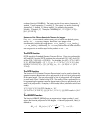
Page 5-13
multiplying j times k in modulus n arithmetic is, in essence, the integer
remainder of j
⋅
k/n in infinite arithmetic, if j
⋅
k>n. For example, in modulus 12
arithmetic we have 7
⋅
3 = 21 = 12 + 9, (or, 7
⋅
3/12 = 21/12 = 1 + 9/12, i.e.,
the integer reminder of 21/12 is 9). We can now write 7
⋅
3 ≡ 9 (mod 12), and
read the latter result as “seven times three is congruent to nine, modulus twelve.”
The operation of division can be defined in terms of multiplication as follows, r/
k
≡
j (mod n), if, j
⋅
k
≡
r (mod n). This means that r must be the remainder of
j
⋅
k/n. For example, 9/7 ≡ 3 (mod 12), because 7⋅3 ≡ 9 (mod 12). Some
divisions are not permitted in modular arithmetic. For example, in modulus 12
arithmetic you cannot define 5/6 (mod 12) because the multiplication table of
6 does not show the result 5 in modulus 12 arithmetic. This multiplication table
is shown below:
Formal definition of a finite arithmetic ring
The expression a
≡
b (mod n) is interpreted as “a is congruent to b, modulo n,”
and holds if (b-a) is a multiple of n. With this definition the rules of arithmetic
simplify to the following:
If a
≡
b (mod n) and c
≡
d (mod n),
then
a+c
≡
b+d (mod n),
a-c
≡
b - d (mod n),
a
×c
≡
b×d (mod n).
For division, follow the rules presented earlier. For example, 17
≡ 5 (mod 6),
and 21
≡ 3 (mod 6). Using these rules, we can write:
17 + 21
≡ 5 + 3 (mod 6) => 38 ≡ 8 (mod 6) => 38 ≡ 2 (mod 6)
17 – 21
≡ 5 - 3 (mod 6) => -4 ≡ 2 (mod 6)
17
× 21 ≡ 5 × 3 (mod 6) => 357 ≡ 15 (mod 6) => 357 ≡ 3 (mod 6)
6*0 (mod 12) 0 6*6 (mod 12) 0
6*1 (mod 12) 6 6*7 (mod 12) 6
6*2 (mod 12) 0 6*8 (mod 12) 0
6*3 (mod 12) 6 6*9 (mod 12) 6
6*4 (mod 12) 0 6*10 (mod 12) 0
6*5 (mod 12) 6 6*11 (mod 12) 6


















